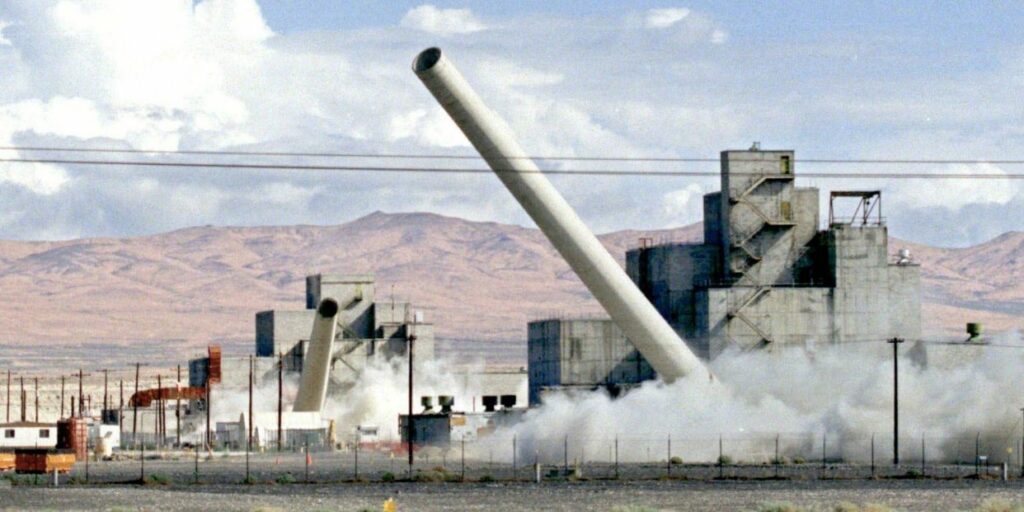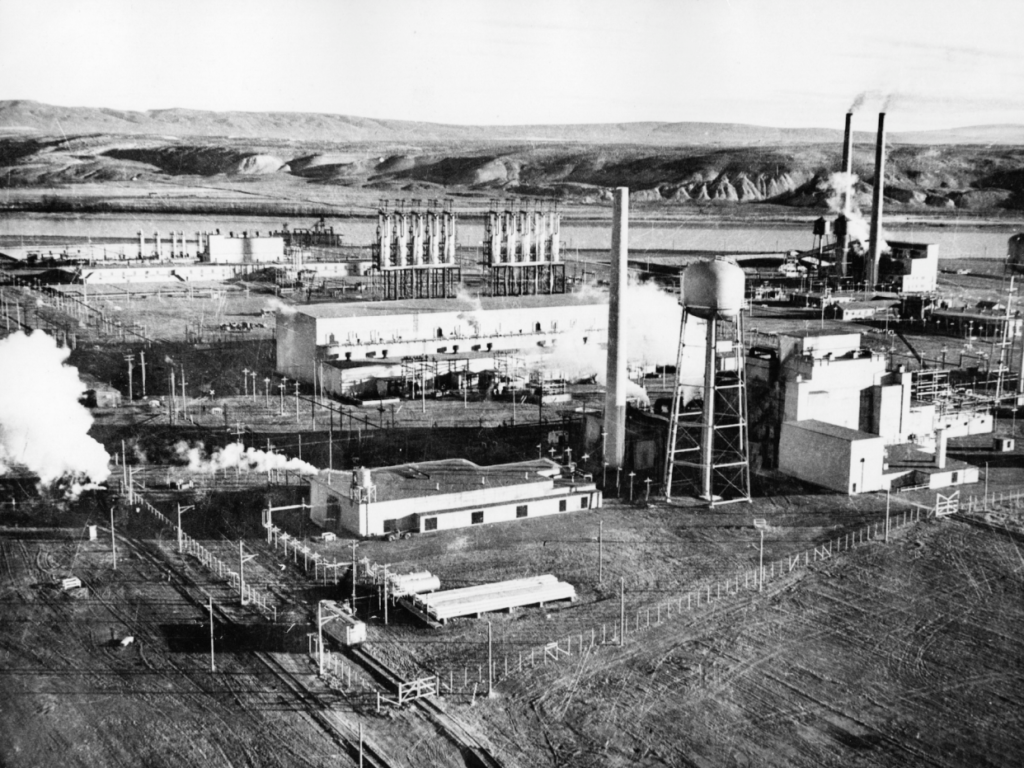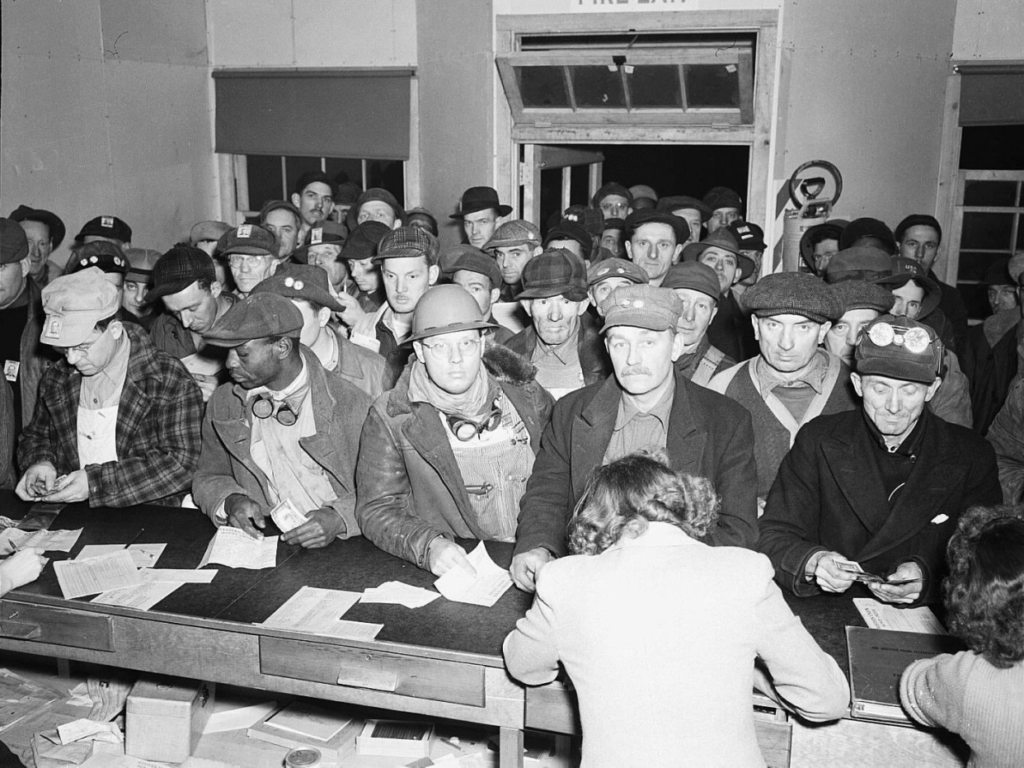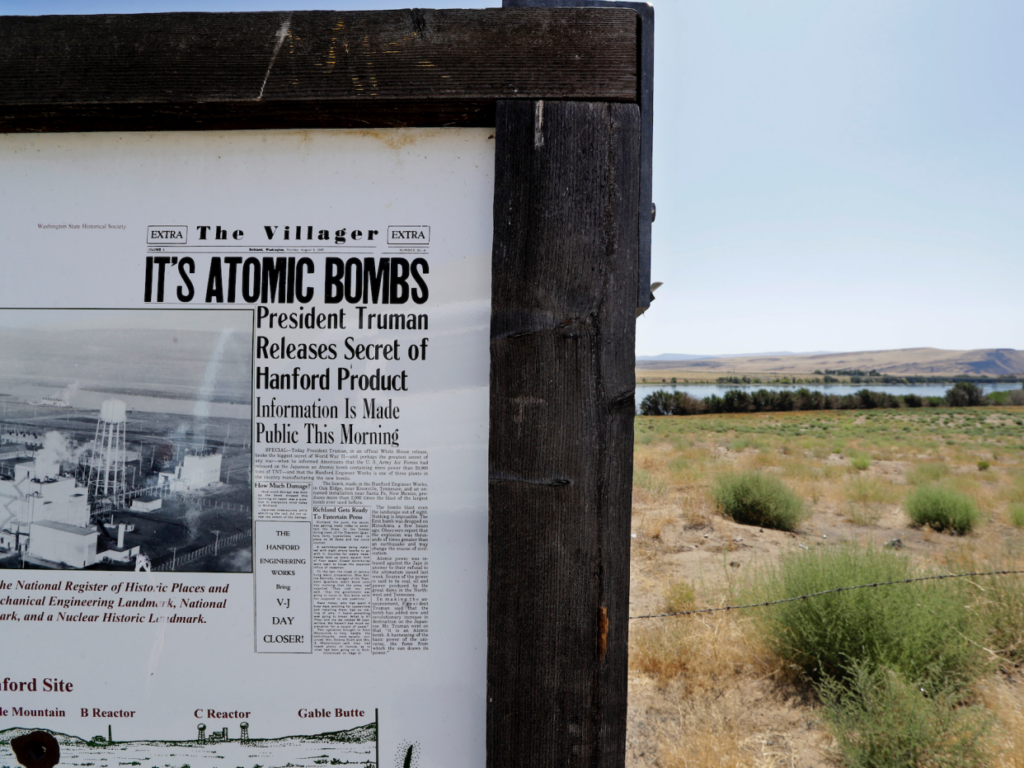Inside America’s Most Toxic Nuclear Waste Dump, Where 56 Million Gallons of Buried Radioactive Sludge Are Leaking into the Earth
ANGLO AMERICA, ENERGY, ENVIRONMENT, 7 Oct 2019
James Pasley | Yahoo! News – TRANSCEND Media Service

The stacks of two Department of Energy production reactors fall in a simultaneous demolition at the Hanford Nuclear Reservation near Richland, Wash., Saturday, Aug. 14, 1999.
Jackie Johnston / AP
- Hanford Nuclear Reservation is the most polluted area in the United States. Buried beneath the complex is 56 million gallons of radioactive waste that need to be dealt with.
- The reservation produced the plutonium for Fat Man, the atomic bomb that was dropped on Nagasaki in Japan, as well as for the United States’ atomic weapon stockpile during the Cold War.
- In June 2019, President Trump’s administration announced it would downgrade the threat levels of some radioactive waste to save the government $40 billion on cleanup.
- The announcement has been criticized as a way to make cleaning up nuclear waste easier, without actually doing the clean-up part.
- Trump’s administration also wants to cut Hanford’s funding by $416 million. But the cleanup needs more funding, not less.
23 Sep 2019 – Sitting on 586 square miles of desert in Washington, the Hanford Nuclear Reservation is the most toxic place in America.
Buried beneath the ground, in storage tanks, are 56 million gallons of radioactive waste. Many of them are leaking into the ground.
According to NBC, some nuclear experts have said Hanford is “an underground Chernobyl waiting to happen.”
Hanford produced the plutonium to build Fat Man, the atomic weapon that was detonated above Nagasaki at the end of World War II, and for the United States’s nuclear arsenal during the Cold War.
In 1989, after years of dismissing concerns about contamination, the reservation’s management finally admitted the site needed to be cleaned up. But cleaning up nuclear waste is difficult. It can’t be burned or buried. The plan is to build a waste management plant that will turn the waste into glass, which can be stored away for thousands of years. It’s a slow, costly process.
As The Daily Beast reported, “Hanford is the worst kind of mess: the kind that humanity is capable of making, but not capable of cleaning up.”
The longer the contaminated materials are left, the worse they become. Here’s what the nuclear reservation is like.
The government was wary of the repercussions of a major incident and chose an isolated location, away from cities on the East Coast. But it’s in an area prone to wildfires and possible earthquakes.
The last big earthquake in the area was in 1936. But another sizeable one could release radiation, like what happened with the nuclear power plant in Fukushima, Japan, in 2011.

The Columbia River passes Hanford to the north and the east by a few miles, and it’s downstream from two dams. Elaine Thompson / AP
The government wanted the site to be close to dams for electricity, and close to the river so it had a source of cool liquid to cool the reactors.
In 2017, the EPA said contaminated groundwater was flowing freely into the river.

The Hanford Nuclear Reservation began operating on September 6, 1944.
Hulton-Deutsch / Hulton-Deutsch Collection / Corbis / Getty
Hanford played a vital part in the top-secret Manhattan Project, which was the government’s research and development program for nuclear weapons.
The government purchased the land in 1943, and gave about 1,500 people 30 days to leave.

The first reactor was built in 11 months, and the majority of the 50,000 person workforce did not know what it was that they were working on… Wikimedia
Sources: Court House News, Los Angeles Times
Source: Court House News

To keep the nuclear complex secret, the government banned trespassing and set up a buffer zone called Hanford Reach.
Elaine Thompson / AP
Instead of the land being developed by farmers and ranchers, it’s been left untouched for 75 years, and wildlife has boomed. In 2000, former President Bill Clinton made the 195,000 acre area a National Monument.
In the area, there are herds of elk, Chinook salmon breed in stretches of the river in Autumn, and there is also an abundance of birds, including burrowing owls, Swainson hawks, and sagebrush sparrows.
TO CONTINUE READING Go to Original – news.yahoo.com
Tags: Arms Industry, Arms Race, Arms trade treaty, Atomic Weapons, Capitalism, Chernobyl, China, Conflict, Economics, Energy, Environment, European Union, Fukushima, Geopolitics, History, Human Rights, Indigenous Rights, International Relations, Japan, Military, NATO, Nuclear Ban Treaty, Nuclear Disaster, Nuclear Energy, Nuclear Meltdown, Nuclear Power, Nuclear Waste, Nuclear Weapons, Nuclear club, Nuclear war, Pacific Islands, Politics, Pollution, Power, Public Health, Russia, Social justice, Three Mile Island, UK, UN, USA, Violence, War, West, World
DISCLAIMER: The statements, views and opinions expressed in pieces republished here are solely those of the authors and do not necessarily represent those of TMS. In accordance with title 17 U.S.C. section 107, this material is distributed without profit to those who have expressed a prior interest in receiving the included information for research and educational purposes. TMS has no affiliation whatsoever with the originator of this article nor is TMS endorsed or sponsored by the originator. “GO TO ORIGINAL” links are provided as a convenience to our readers and allow for verification of authenticity. However, as originating pages are often updated by their originating host sites, the versions posted may not match the versions our readers view when clicking the “GO TO ORIGINAL” links. This site contains copyrighted material the use of which has not always been specifically authorized by the copyright owner. We are making such material available in our efforts to advance understanding of environmental, political, human rights, economic, democracy, scientific, and social justice issues, etc. We believe this constitutes a ‘fair use’ of any such copyrighted material as provided for in section 107 of the US Copyright Law. In accordance with Title 17 U.S.C. Section 107, the material on this site is distributed without profit to those who have expressed a prior interest in receiving the included information for research and educational purposes. For more information go to: http://www.law.cornell.edu/uscode/17/107.shtml. If you wish to use copyrighted material from this site for purposes of your own that go beyond ‘fair use’, you must obtain permission from the copyright owner.
Read more
Click here to go to the current weekly digest or pick another article:
ANGLO AMERICA:
- Venezuela’s Oil, US-led Regime Change, and Washington’s Gangster Politics
- US Wealthiest Billionaires Got $698 Billion Richer This Year
- Zohran Mamdani's Win Is "the Loss for the Jews": The Real American Revolution without the French Hair Cut
ENERGY:
- China Opens World’s Largest Offshore Solar Power Facility
- Nuclear Industry Takes Control of NASA
- The Nuclear Energy Dilemma: Climate Savior or Existential Threat?
ENVIRONMENT:

